I've hiked the Inca Trail to Machu Picchu twice and also lived for a while in Cusco.
In this article, you will find all the information you need to prepare for an amazing Inca trail hiking experience.
You will also find pro-tips on everything from acclimatisation and altitude sickness, routes (including the 4-day, 2-day and Salkantay/Inca combo), when to book your Inca trek, information on costs, permits, tour operators and other frequently asked questions.
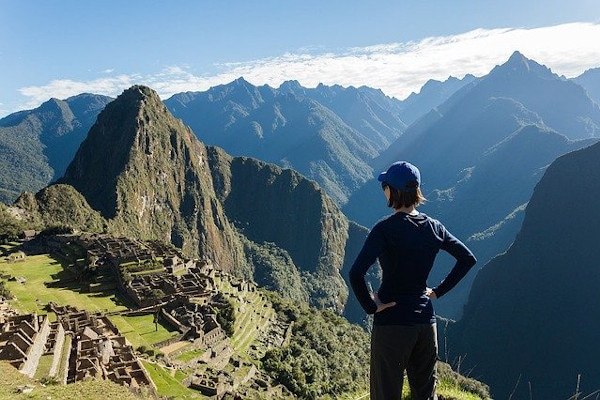
Get a Inca Trail trek quote
Start planning your Machu Picchu hiking holiday.
Inca Trail Trek - The Ultimate Guide
What are the Inca Trail route options?
If you are wondering if the Inca Trail is worth it, the answer is ‘Yes!’.
This multi-day trail will give you a chance to experience Peru’s beautiful habitats and explore ancient ruins.
There are a number of hikes to Machu Picchu, but none are as popular, or arguably as impressive, as the Inca trail trek to Machu Picchu.
There are three main Inca Trail routes:
- 4-day Inca Trail
- 2-day Inca Trail
- Salkantay / Inca Combo
Classic Inca Trail - 4D/3N
The classic Inca Trail Trek is 26miles / 43km long. This is divided into four days with three nights being spent in designated campsites along the Inca trail.
This is the most popular of the Inca Trail itineraries as you get to experience several Peruvian habitats and see the most ruins. The 4 Day Inca Trail starts at KM82 and ends at the Sun Gate of Machu Picchu.
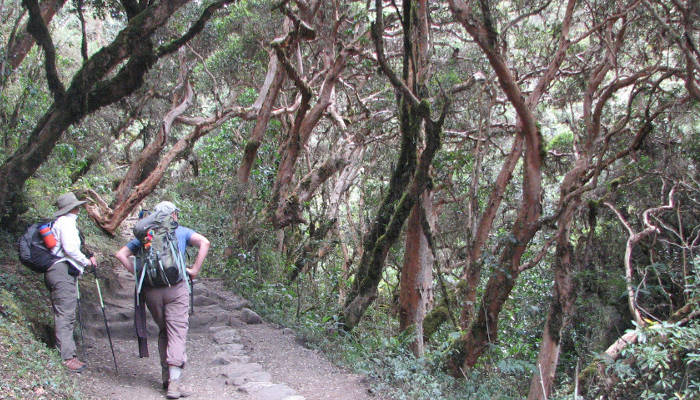
2 Day Inca Trail - 2D/1N
The 2-Day Inca Trail is ideal for those with limited time. It is popular because you still get to enter Machu Picchu through the Sun Gate. The hike is 7.5 miles / 12km long, starting at KM104 and ending at Machu Picchu.
This is a single day of walking with a stay-over in Aguas Calientes. For this reason, some tour operators refer to this route as the 1-day Inca Trail.
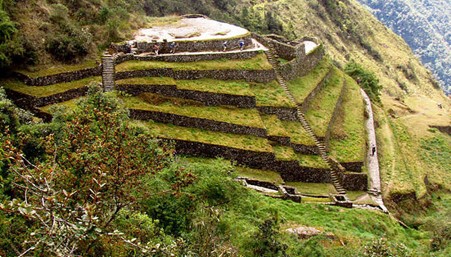
7 Day Inca Trail / Salkantay Inca Combo
The 7-Day Inca Trail combines the Salkantay Hike with the Classic Inca Trail. This challenging route is 47 miles / 75km long. This epic, 7-day hike to Machu Picchu is perfect for fitter trekkers.
The Salkantay-Inca Combo lets you experience highlights of both trails.
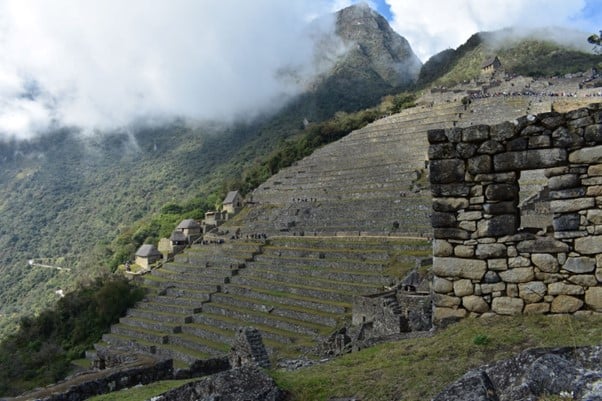
Read about all the different routes to Machu Picchu, including the Salkantay, Lares and Choquequirao.
How Long Is The Inca Trail?
The classic 4-day Inca Trail is 26miles / 43km long, however, there is also a short Inca Trail which is 7.5 miles / 12km long.
How Hard Is The Inca Trail?
The Inca Trail is rated as a moderate hike. Most people will be able to manage the trail provided they are healthy and fairly active. It may give you peace of mind to know that thousands of people successfully complete the Inca trek each year.
However, the 4-day trail is not all smooth sailing. There are some difficult parts over steep mountain passes. These challenging sections are over stone stairs which can be tough on the knees.
If you are not sure whether you will be up for it, check out this article on Inca Trail Difficulty.
How Much Does The Inca Trail Cost?
You have probably already noticed major differences in Inca Trail tour prices. The costs mainly vary depending on group size, transport type, and accommodation. Be aware that you will get what you pay for in terms of quality and experience.
Only registered and licensed Inca trail trekking companies can offer this hike. There is limited permit availability compared to the high demand. This makes the Inca Trail one of the more expensive treks in South America.
If you are on a tight budget, here are a few ways you can save money on the Inca Trail. Alternatively, you may want to splurge and enjoy the perks of a luxury Inca Trail tour.
We provide detailed guidance on Inca trail costs here. At a glance, these are the prices you can expect to pay:
- Local Operators: $600-$900 per person
- International Trek Operators: $1000-2000 per person
- Private / Luxury Tours: $2000-$3500 per person

Get a Inca Trail trek quote
Start planning your Machu Picchu hiking holiday.
When Is The Best Time To Hike The Inca Trail?
The best time to hike the Inca Trail is during the Andean dry season (June to August). At this time of year, there is less chance of rain and days are clear and sunny. These months are also the busiest on the trail.
If you are looking to avoid crowds and still enjoy good weather, I would recommend hiking in May or October. Check out our more detailed report on Inca Trail weather.
The only time of year when the Inca Trail is closed is over February. This is partially for safety reasons because landslides are particularly common over this month.
Are you looking to hike the Inca Trail during out-of-season months? Read our best time to hike the Inca Trail article.
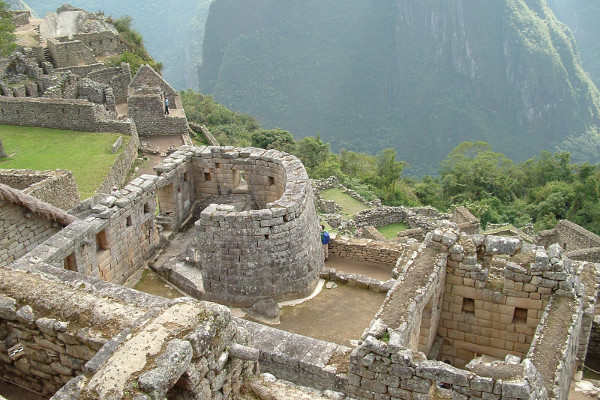
What Are The Logistics For Hiking The Inca Trail?
Before hiking the Inca Trail, there are a few logistics you should keep in mind.
You Need A Permit For The Inca Trail
Because of the classic Trail's popularity, the Peruvian Government has initiated restrictions on hiker numbers on the Inca Trail. These limits help minimize negative impacts on the ancient infrastructure and the surrounding environment.
As of 2001, only 500 people are allowed on the trail each day. This is the total number that includes tourists, porters, and guides. Anyone wishing to trek the classic route will need to obtain a permit prior to their departure.
Permits are sold on a first-come-first-serve basis and often sell out up to a year ahead for the popular months (June-August). These documents are like gold, so you need to book well in advance!
Here, we have compiled a lot more information about the Inca Trail permit system.
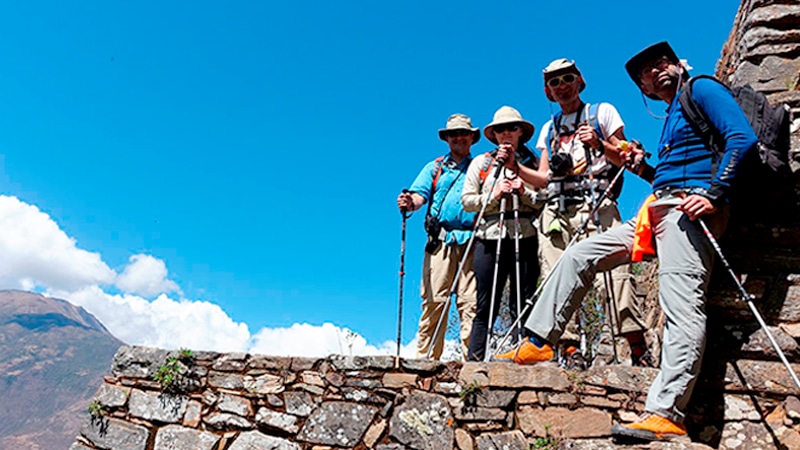
You Need A Registered Guide To Hike The Inca Trail
You are not able to hike the Inca Trail without a guide. The second part of the Peruvian Government regulations states that only authorised tour companies can obtain permits.
This means you’ll need to go through an operator to purchase your permit.
You Cannot Purchase Last-Minute Inca Trail Tickets
I often get asked if you can purchase last-minute cancellation permits. Sadly, the answer is 'no', as all permits are paired with an individual’s passport number. The Government has strict control policies. Permits and passports are compared at several checkpoints.
When booking with a tour company, be sure to write down all your details accurately. Any error in personal details cannot be changed. If the information on your permit is wrong, you won’t be allowed onto the trail or into Machu Picchu.
Do I Need To Train For The Inca Trail?
Regardless of your age and fitness, I recommend that you do some sort of preparation for the Inca Trail. Following a 1-3 month Inca Trail training program will help you cope better with ascents and high altitudes.
The Classic 4-day Inca hike and the Salkantay / Classic Trail Combo are both moderate to tough treks (the latter in particular). You don’t need to be a marathon runner, but you should be in relatively good shape to hike the Inca Trail.
The best type of training you can do is aerobic cardiovascular exercise. Long-distance jogging, swimming, or cycling are all good ways to build hiking fitness.
Looking for a day tour? Here are my 5 favourite day tours around Cusco:
- Rainbow Mountain day trip (with meals)
- Moray and Salt Mines Quad Bike Tour
- Sacred Valley day tour
- Humantay Lake day tour
- Machu Picchu and Huayna Picchu entrance tickets
See more Cusco day trips.
How Do I Deal With Acclimatisation and Altitude Sickness On The Inca Trail?
The Classic Trail is a high altitude trek that reaches a maximum height of just over 4,200m / 13,780 ft. This means that there is a risk of experiencing altitude sickness.
Unfortunately, it is nearly impossible to predict one’s susceptibility to altitude sickness. There is very little correlation between age, gender and fitness. One thing we do know is that going too high, too fast is a key contributing factor to getting altitude sickness.
The best thing you can do to avoid altitude sickness is to spend time acclimatising. It is best to stay at least 2 days in Cusco prior to starting the trek.
Cusco has an elevation of 3,400m / 11,155 ft. It is possible that you may start experiencing altitude sickness symptoms while in this city. But it’s better to experience it here where medical assistance is readily available than higher up on the slopes heading to Machu Picchu.
We have written a helpful online guide to acclimatisation and altitude sickness and I recommend you take a moment to read it.

Get a Inca Trail trek quote
Start planning your Machu Picchu hiking holiday.
What Do I Pack For The Inca Trail?
The Inca Trail is a trekking experience that requires fundamental hiking equipment.
Many people arrive in Cusco woefully underprepared, which can have a negative impact on one’s trekking experience.
To help you pack correctly for the Inca trek, we have put together the Ultimate Inca Trail Packing List. You can use these insights to find out exactly what you need to take and what can be left behind, rented or even bought in Cusco.
You may also like...
How Do I Choose An Inca Trail Tour?
When deciding which Inca Trail tour company to book with, there are a few key aspects to consider. Most importantly, the company you select needs to be an officially registered tour operator.
Next, you need to establish what the company’s reputation is. It is important to get a good sense of how they treat their staff and the quality of equipment they use. Your budget will also factor into the decision.
When looking at tours, make sure basic prices include the following:
- Transport to the start point (KM82)
- Entrance fees for the Inca trail and Machu Picchu
- All your meals on the trek
- A full complement of support staff (porters and a guide)
- Camping gear (tent, sleeping mat)
- A guided tour of Machu Picchu
- Your return bus ticket and train ticket back to Cusco from Aguas Calientes
To help you decide, I've reviewed some of the top Inca Trail Tour Operators.
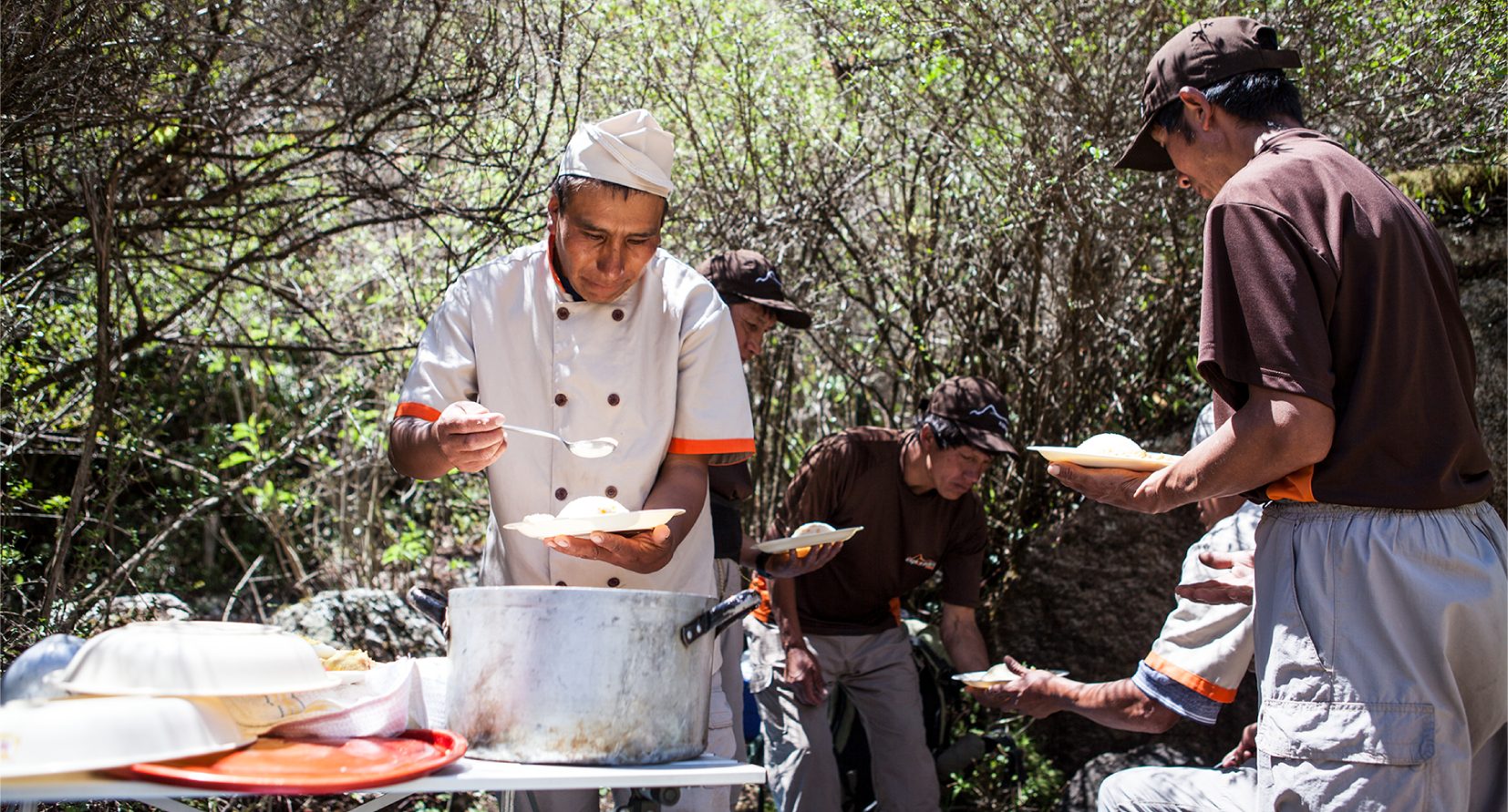
What Amount Should You Tip For The Inca Trail?
The trekking team plays a big role in contributing to the amazing experience that is the Inca Trail. After spending 4 days with your guide, cooks and porters, you will find that you not only need to, but want to give them something extra.
It is hard to know what a good tipping amount is. Here are a few tipping guidelines:
- 60-80 soles per porter ($15-$20)
- 150 soles per chef ($35-$40)
- 250-400 soles for the guide ($45-$100)
These tipping amounts can be pooled together by the hiking group. Bring smaller notes so that you can tip people separately. Read our full article on tipping on the Inca Trail and Porter Welfare.
Giving a gratuity is by no means obligatory However, this is the norm and you will quickly discover that it is expected.
Staff welfare is a major problem on the trail. Porters in particular are sometimes woefully underpaid. These hard workers often rely on tips to make up the balance of their earnings, so please keep that in mind during your trek.
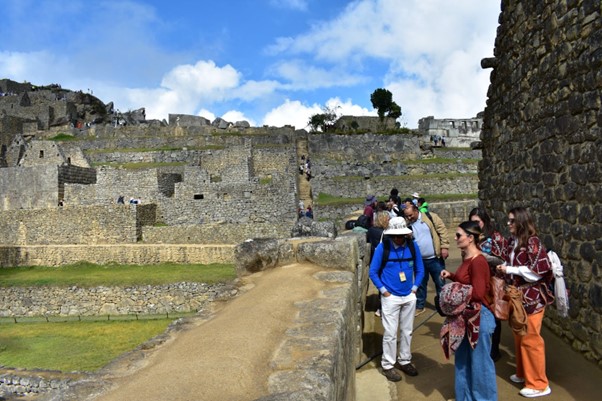
What Are Covid-19 Regulations For The Inca Trail And Machu Picchu?
Following almost two years of pandemic restrictions, the Inca Trail is open! Bookings for this popular trek have almost gone back to normal. However, there are a few protocols you need to still follow relating to Covid-19.
Looking for the latest information on the Coronavirus situation in Peru? Here is everything you need to know about hiking to Machu Picchu and Coronavirus restrictions.

Get a Inca Trail trek quote
Start planning your Machu Picchu hiking holiday.
Is The Inca Trail Dangerous?
The Inca Trail is considered a safe and non-technical hike. The path is well maintained and there are no risky sections where you would need to climb or scramble over loose rocks.
Just like any other outdoor activity, you do still need to take care. There are a few dangerous aspects to be aware of, most notably landslides.
Most risks can be reduced or avoided altogether. Take a minute to read about the Inca Trail’s potential dangers (and how to avoid them).
Despite thousands of hikers, there have been very few fatalities over the trails existence. Most deaths on the Inca Trail can be attributed to freak accidents or human error.
Do I Need Travel Insurance For The Inca Trail?
Insurance for your trek to Machu Picchu is a must. Most operators will require you to carry sufficient travel insurance for your trek.
As most trails to Machu Picchu go over high 4,000m / 13,123 ft passes, you will need to make sure your insurance covers you for high altitude hiking (up to 6,000m / 19,685 ft). I have reviewed a number of travel insurance providers and the most affordable and best by far is Rise & Shield.
Use the Calculator below to get a travel insurance quote for your trek.
Why Is The Inca Trail Famous?
Today, thousands of hikers complete the Inca Trail each year. It is considered one of the greatest trails in the world.
The trail is special because it follows the same route that Incan Royalty used to reach the sacred settlement of Machu Picchu. Hiking the Inca Trail is a unique opportunity to connect to this 500-year old civilisation.
It is often said that the journey is more important than the destination.
On the Inca Trail, you will not only have a once-in-a-lifetime trek but you will also arrive at Machu Picchu in the best way possible - through the Sun Gate.
Hiram Bingham discovered Machu Picchu and uncovered the trails leading up to it between 1911-1915. The 4-day trek became popular with tour groups in the early 90s.
Find out more about the Inca Trail’s history.
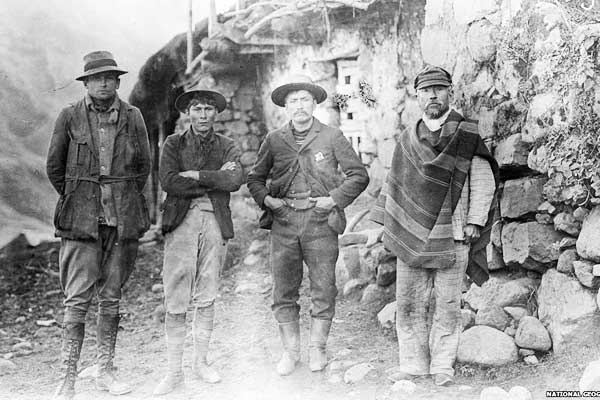
Recommended Reading - Inca Trail Books
If you would like to read up on the Inca Trail before a proposed hiking trip, here are some of my favourite reads:
- The White Rock - Hugh Thompson
- Lost City Of The Incas - Hiram Bingham
- Turn Right At Machu Picchu: Rediscovering The Lost City One Step At A Time - Mark Adams
- The Last Days Of The Incas - Kim Maquarrie
Conclusion
If you have any other questions about the Inca trek, or would like to provide some feedback, please leave a comment below and we will respond within 24 hours.
References: (1) Wikipedia, (2) The Machu Picchu Guidebook, (3) Personal experience, (4) In-depth interviews with guides and tour operators, (5) Andean Travel Web

Hi Alison, thanks for putting this article together.
Do you know if it is possible to find an "independent guide" that you speak of that would be willing to meet us in Ollytayambu train station (or maybe even at 104km) to do the 1 day Inca Trail ending the night in Águas Calientes? The issue we are having is that we booked our entrance ticket already for 1pm at Machu Piccu and as a late idea, decided to do the shorter trek. Obviously, we do not want to waste money on what we have booked already. Alot of operators start and finish in Cusco and when asked about changing it to suit, a token gesture is made which is not exactly value for money. Perhaps an independent guide will give us a better price? How to I find one in advance to to ensure we have something booked? We are restricted on time and have to do it on a certain day. Can you advise or hook us up? Many thanks.
That could be quite tricky. If it wasn’t the Inca trail it would be doable, but the Inca trail is highly regulated and only registered guides can take you onto it. I recommend chatting with a local operator. They might be able to help.